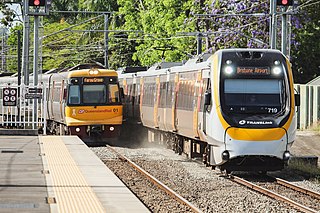
Queensland Rail (QR) is a railway operator in Queensland, Australia. Owned by the Queensland Government, it operates local and long-distance passenger services, as well as owning and maintaining rolling stock and approximately 6,600 kilometres (4,101 mi) of track and related infrastructure.

The Ferny Grove railway line is a 13-kilometre (8 mi) suburban railway line in Brisbane, the state capital of Queensland, Australia. It is part of the Queensland Rail Citytrain network.
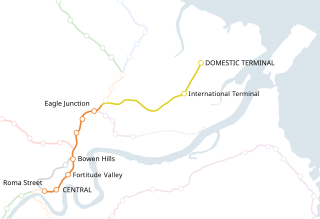
Airtrain is the privately owned commuter railway line that extends 13.0 km (8.1 mi) northeast from Brisbane, the state capital of Queensland, to Brisbane Airport (BNE) at both its separate International and Domestic terminals. It was opened in 2001.

The Doomben railway line is a railway line in the City of Brisbane, Queensland, Australia. It is the part of the Pinkenba railway line that still operates a regular passenger service. Doomben, or dumben, is the Indigenous Yuggera name for a tree fern which was prolific in the area. The railway line branches from the North Coast line at Eagle Junction, extending 8 kilometres (5.0 mi) to the industrial suburb of Pinkenba, situated on the northern bank at the mouth of the Brisbane River. It is part of the Queensland Rail Citytrain network.

The Shorncliffe railway line is an 11 kilometres (6.8 mi) suburban railway line situated north of Brisbane, the state capital of Queensland, Australia. It is part of the Queensland Rail Citytrain network.

The Ipswich and Rosewood line refers to the section of the Main Line to Toowoomba that has a regular suburban rail service, extending southwest from the Brisbane central business district. It is part of the Queensland Rail City network.

The Cleveland railway line is a suburban railway line extending 37.3 kilometres (23.2 mi) east-southeast from Brisbane, the state capital of Queensland, Australia. It is part of the Queensland Rail Citytrain network.

Darra railway station is located on the Main line in Queensland, Australia. It serves the Brisbane suburb of Darra.
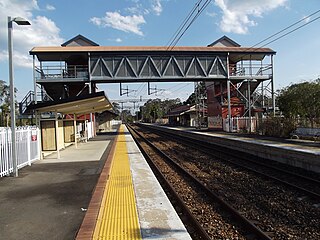
Landsborough railway station is located on the North Coast line in Queensland, Australia. It serves the town of Landsborough in the Sunshine Coast Region.
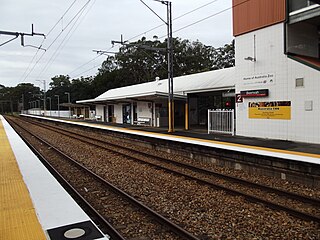
Beerwah railway station is a heritage-listed railway station on the North Coast line in Queensland, Australia. It serves the town of Beerwah in the Sunshine Coast Region. It is listed on the Sunshine Coast Region Heritage Register.

Beerburrum railway station is located on the North Coast line in Queensland, Australia. It serves the town of Beerburrum in the Sunshine Coast Region.

Elimbah railway station is located on the North Coast line in Queensland, Australia. It serves the town of Elimbah in the City of Moreton Bay.

Springfield railway line is a 13.6 km (8.5 mi) suburban railway line in Brisbane, Australia that branches from the Ipswich/Rosewood line after Darra railway station. Construction of the line started on 5 July 2010, and it opened on 2 December 2013. The line was developed along with the widening of the nearby Centenary Motorway.

The rail network in Queensland, Australia, was the first in the world to adopt 1,067 mm narrow gauge for a main line, and now the second largest narrow gauge network in the world, consists of:

The Gold Coast is the largest regional city and fastest growing city in Australia. As a result, the Gold Coast has a wide range of public and private transport options from cars and bikes to buses, heavy rail and light rail. The car is the dominant mode of transport in the city with an extensive arterial road network that connects the standard residential streets with major suburbs and motorways.

The Electric multiple unit (EMU) is a class of electric multiple units manufactured by Walkers at Maryborough for Queensland Rail between 1979 and 1986. They were the first EMUs in Queensland and are progressively being retired from the Queensland Rail Citytrain network.

The InterCity Express was a class of electric multiple units manufactured by Walkers, Maryborough for Queensland Rail in 1988/89. They were built to operate the Spirit of Capricorn service on the North Coast line service between Brisbane and Rockhampton. Since being superseded on this service, they were used on Sunshine Coast line services from Brisbane to Gympie North until mid-2021. As of November 2021, all units have been retired from service.
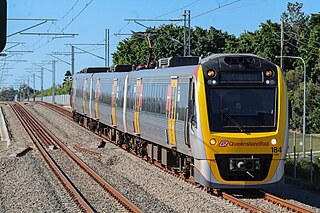
The Interurban multiple units (IMU) are a class of electric multiple units manufactured by Walkers Limited/Downer EDI Rail, Maryborough for Queensland Rail's Citytrain division between 1996 and 2011. The IMU is divided into in three subclasses, units 101-110 as the 100 series, units 121-124 as the 120 series, and units 161-188, as the 160 series.
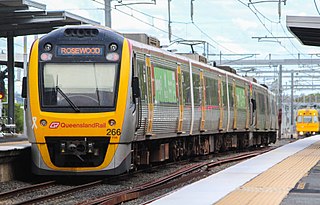
The Suburban multiple units (SMU) are a class of electric multiple units manufactured by Walkers Limited/Downer EDI Rail, Maryborough for Queensland Rail's Citytrain division between 1994 and 2011. The SMU is divided into in three subclasses, units 201-212 as the 200 series, units 221-250 as the 220 series, and units 261-296, as the 260 series.
In the late 1970s and 1980s, a significant rail electrification program was completed in the Australian state of Queensland. The electrified Queensland network is the largest in Australia with over 2,000 kilometres electrified, the next biggest is New South Wales with 640 kilometres, that is served mainly as passenger operations.





























